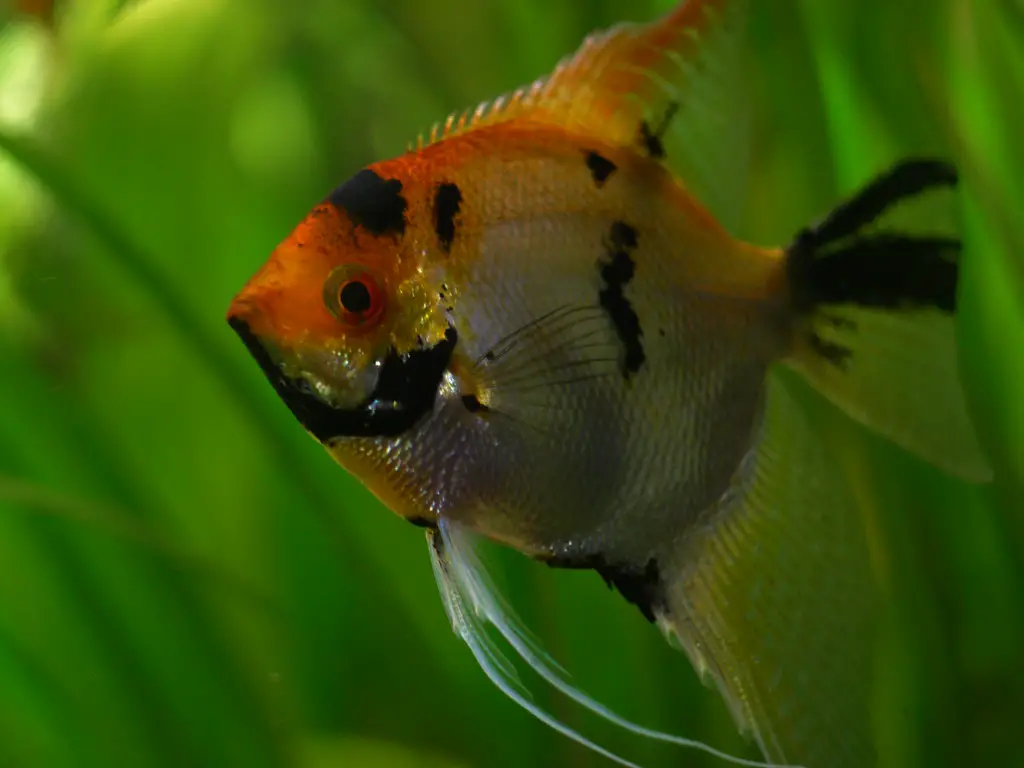Choosing the best tank for your beautiful friend is no doubt a very difficult decision to make. Usually, when you have varieties of option available in the market, selectng best from them is very confusing. However, if you are new to fish keeping and wants a perfect tank that is easy to care and also holds enough amont of fish, then I would suggest to get a 40 gallon tank. So, what are the best fish for a 40 gallon tank?
There are a number of best fish options for a 40 gallon tank. But as for me, the fish that I think are best for my 40 gallon tank are:
- Goldfish
- Betta fish
- Flowerhorn
- Shell Dwellers
- Mollies
- Swordtails
- Bettas
- Platy
Moreover, along with this, there are many more best fish for a 40 gallon tank, such as Shell dwellers, rock dwellers, Bolivian Ram, Cyprichromis, and Long fin Biestlenose Plecos.
If you are new to fish keeping, all these names might seem alien to you. But don’t worry I will explain about each fish in brief so that this will help you to choose the best one for your 40 gallon tank.
Nevertheless, before heading into each of them, let me first guide you about what should you get for your tank, what to do and what not to do!
What Should You Get For Your 40 Gallon Tank?
Like every machine, your tank also needs some equipment to function properly.
A well-equipped tank will ensure the longevity and the safety of your fish. Here is a list of the things you will need for your 40-gallon tank:
Filter
Filters are no doubt one of the most important pieces of equipment in your tank. It is responsible for keeping the water clean and free of harmful toxins. There are different types of filters available in the market, so it is important to choose one that suits your needs.
I usually go for canister filters as they are powerful and can be hidden away from sight. But if you have a smaller budget, then hang-on-back filters would be a good option too.
Some of the filters that you can choose from are:
- Hydro Professional External Canister Filter
- Eheim Classic External Canister Filter
- Aqua Clear Power Filter IIO
- Fluval FX6 Canister Filter
Heater
A heater is another essential piece of equipment for your tank. It helps to maintain a stable water temperature, which is crucial for the health of your fish. Especially if you have tropical fish, a heater is a must-have.
If you have a 40-gallon tank, we recommend the Eheim Jager Aquarium Thermostat Heater. This heater is fully submersible and features an automatic shut-off feature that kicks in if the water level gets too low.
A good option for your 40-gallon tank would be hygger Saltwater Tank Titanium Tube Submersible Pinpoint Aquarium Heater with Digital Thermostat, IC Temp Controller 200 Watt.
Lighting
Proper lighting is important for the health of your fish and plants. It also helps to create a visually appealing aquarium.
For a 40-gallon tank, we recommend the Fluval Sea CPF Series LED Lighting. This lighting system is fully adjustable and has a built-in timer, so you can easily control the amount of light your fish are getting.
Substrates
The substrate is the material that you put at the bottom of your tank. It can be anything from sand to gravel to rocks.
For a 40-gallon tank, we recommend using gravel as your substrate. Gravel is easy to clean and maintain and looks great in an aquarium. Plus, it’s affordable and widely available.
Plants
Plants are not only beautiful, but they also provide a natural habitat for your fish. They help to oxygenate the water and provide hiding places for your fish.
Some good plants for a 40-gallon tank include java fern, anubias, and sword plants. These plants are all easy to care for and don’t require a lot of light or nutrients.
Air Pump
An air pump is a great way to aerate your tank and keep your fish healthy. It also helps to oxygenate the water, which is important for the health of your plants. A tank without an air pump will often become stagnant and smelly.
The Aqua Culture Air Pump is best for a 40-gallon tank. This air pump is quiet and easy to use, and it comes with everything you need to get started.
Now that you know what you need for your 40-gallon tank, it’s time to choose the best fish for it!
Best Fish For A 40 Gallon Tank
A 40-gallon tank is neither too big nor too small, making it the perfect size for many different types of fish. If you’re looking for the best fish for a 40-gallon tank, we’ve got you covered with our top picks.
Some of my favorite fish for a 40-gallon tank include:
Cory Catfish

Cory catfish are small, bottom-dwelling fish that are native to South America. They are schooling fish, so they should be kept in groups of at least six. Corys prefer tanks that are at least 40 gallons in size, and they do best in water that is warm (around 75 degrees Fahrenheit) and slightly acidic.
Corys are gentle fish that get along well with other peaceful community fish. They are also very active, so they make good tank mates for fish that prefer to stay near the top or middle of the tank. One advantage of keeping Corys is that they help to keep the tank clean by eating algae and uneaten food.
However, one drawback is that they are very sensitive to changes in water parameters, so the tank needs to be well-maintained. Overall, Corys are a great choice for beginner fish keepers. They are relatively easy to care for and make a valuable addition to any community tank.
Banggai Cardinalfish
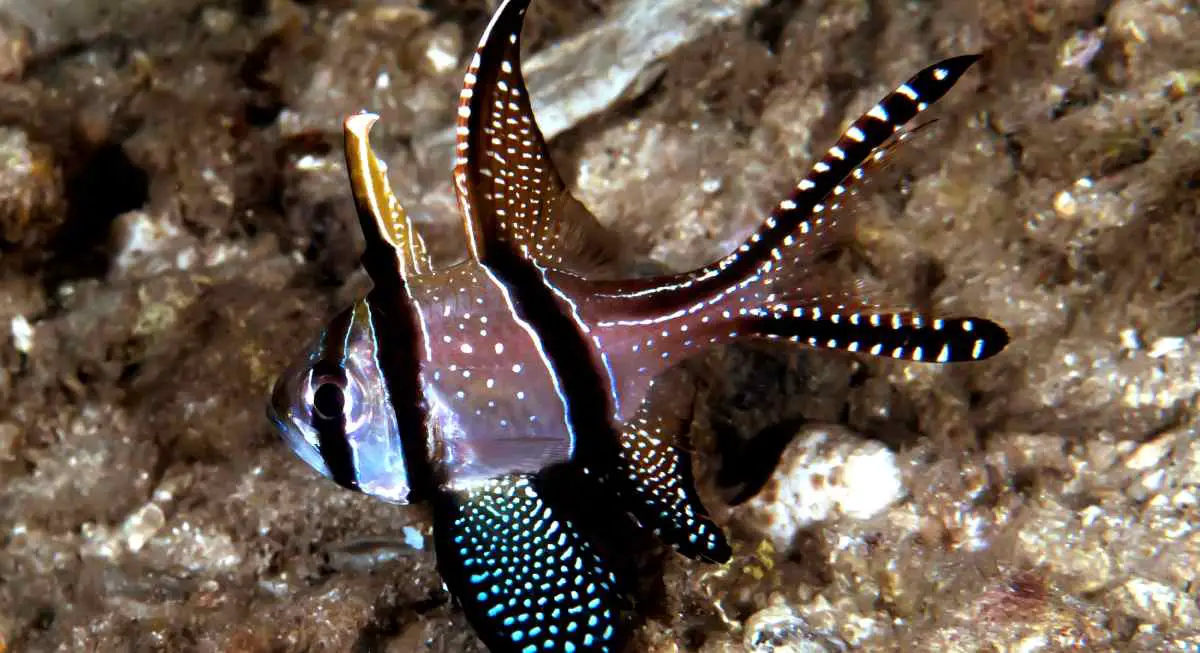
The Banggai cardinalfish is a popular freshwater aquarium fish that originates from the waters around the Banggai Islands off the coast of Indonesia.
The Banggai cardinalfish is a small fish, only growing to be about 3 inches in length. This makes them ideal for smaller tanks like a 40-gallon tank. They are also very hardy fish, so they can tolerate a wide range of water parameters.
However, the ideal water parameters for a Banggai cardinalfish are a pH of 7.5-8.5, a water hardness of 5-20 dGH, and a temperature of 78-82 degrees Fahrenheit. The Banggai cardinalfish is also a peaceful fish that gets along well with other tank mates. As long as their tank mates are not too large, they will do fine in a community tank.
The only drawback of keeping Banggai cardinalfish is that they are an egg-laying species, so they need to have live plants or caves in their tank in order to lay their eggs. Overall, the Banggai cardinalfish is an ideal fish for a 40-gallon tank because of their small size, hardiness, and peaceful nature.
Betta
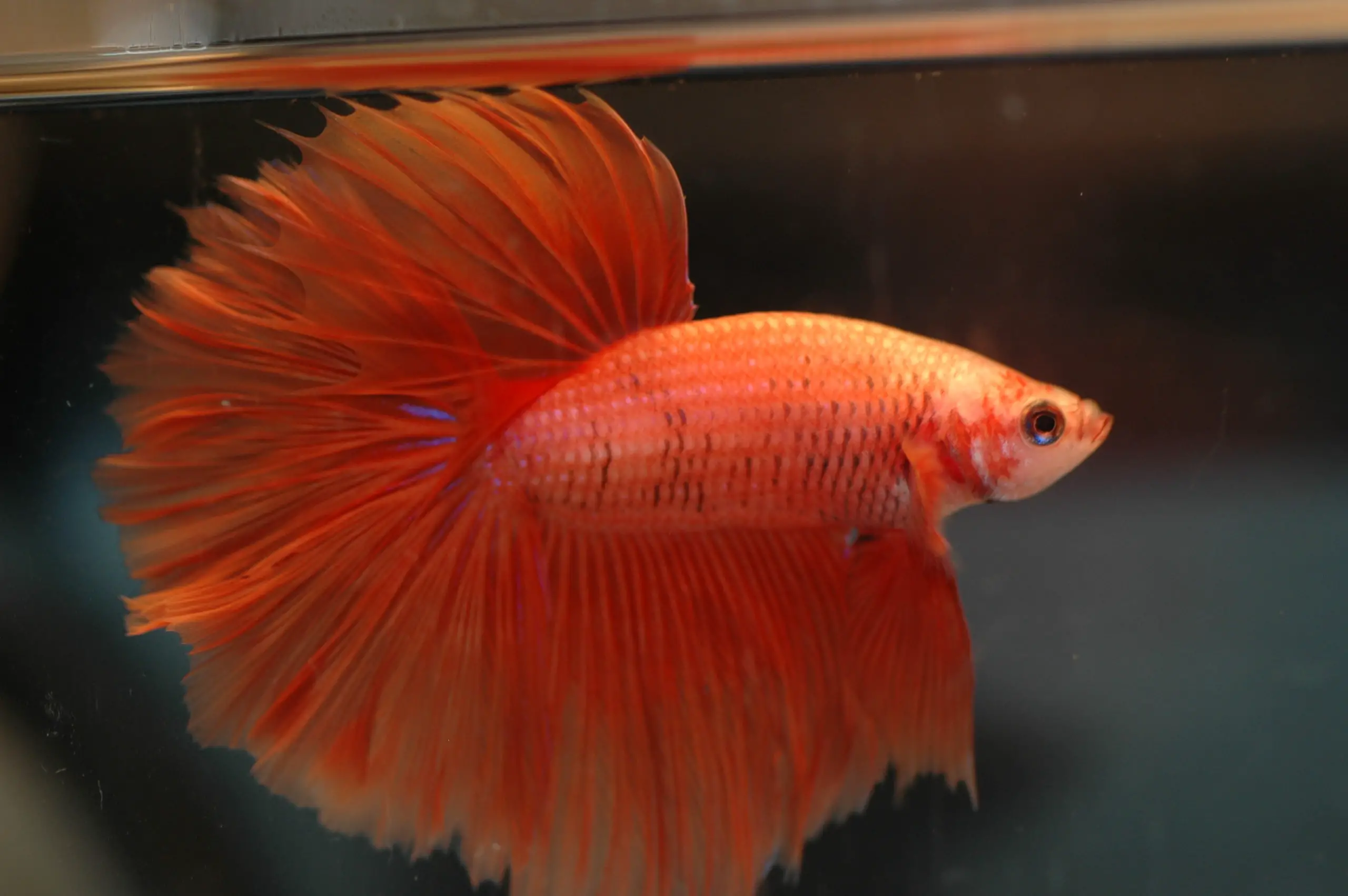
Bettas, also known as Siamese Fighting Fish, are a type of freshwater fish that originates from Southeast Asia. These brightly colored fish are popular pets due to their relatively small size and low maintenance requirements.
Bettas typically grow to be about 2.5 inches long and can live for up to 5 years with proper care. When it comes to setting up a tank for your Betta, it is important to keep the following things in mind: Bettas prefer warm water, so a heater is recommended; they need plenty of hiding places and plants, and they do not do well with other fish (with the exception of certain breeds of female Betta).
As far as tank size goes, a 40-gallon tank is ideal for housing a single Betta. Although you could technically keep more than one Betta in a 40-gallon tank, it is not recommended because these fish are known to be territorial and may fight with each other.
All things considered, the Betta is an excellent choice for a 40-gallon tank. They are beautiful fish that are relatively easy to care for, making them a great option for both beginner and experienced aquarium enthusiasts alike.
Zebrafish
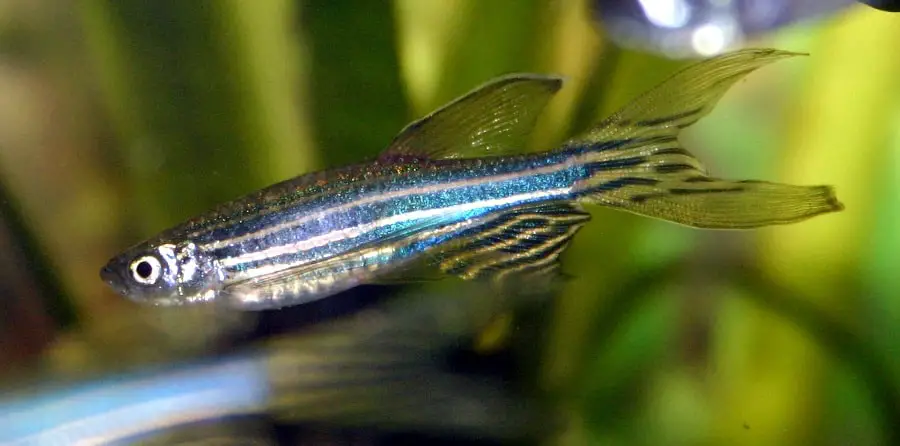
Zebrafish are one of the most popular fish in the aquarium trade. They originate from South Asia, and they typically grow to be about 2.5 inches long. Zebrafish are very hardy fish, and they can adapt to a wide range of water parameters. However, they prefer water that is slightly alkaline, with a pH between 7.0 and 8.0, and cooler water with a temperature between 68 and 72 degrees Fahrenheit.
In terms of tank size, a 40-gallon tank is ideal for housing a small group of zebrafish. These fish are very social creatures, and they thrive in groups of at least five or six individuals. One of the biggest advantages of zebrafish is that they are very low-maintenance fish. They are not picky eaters, and they do not require elaborate filtration or aeration systems.
However, one of the drawbacks of zebrafish is that they are very active swimmers, and they require a lot of open space in their tanks. Otherwise, they can become stressed and start to nip at the fins of their tank mates.
Convict Cichlid
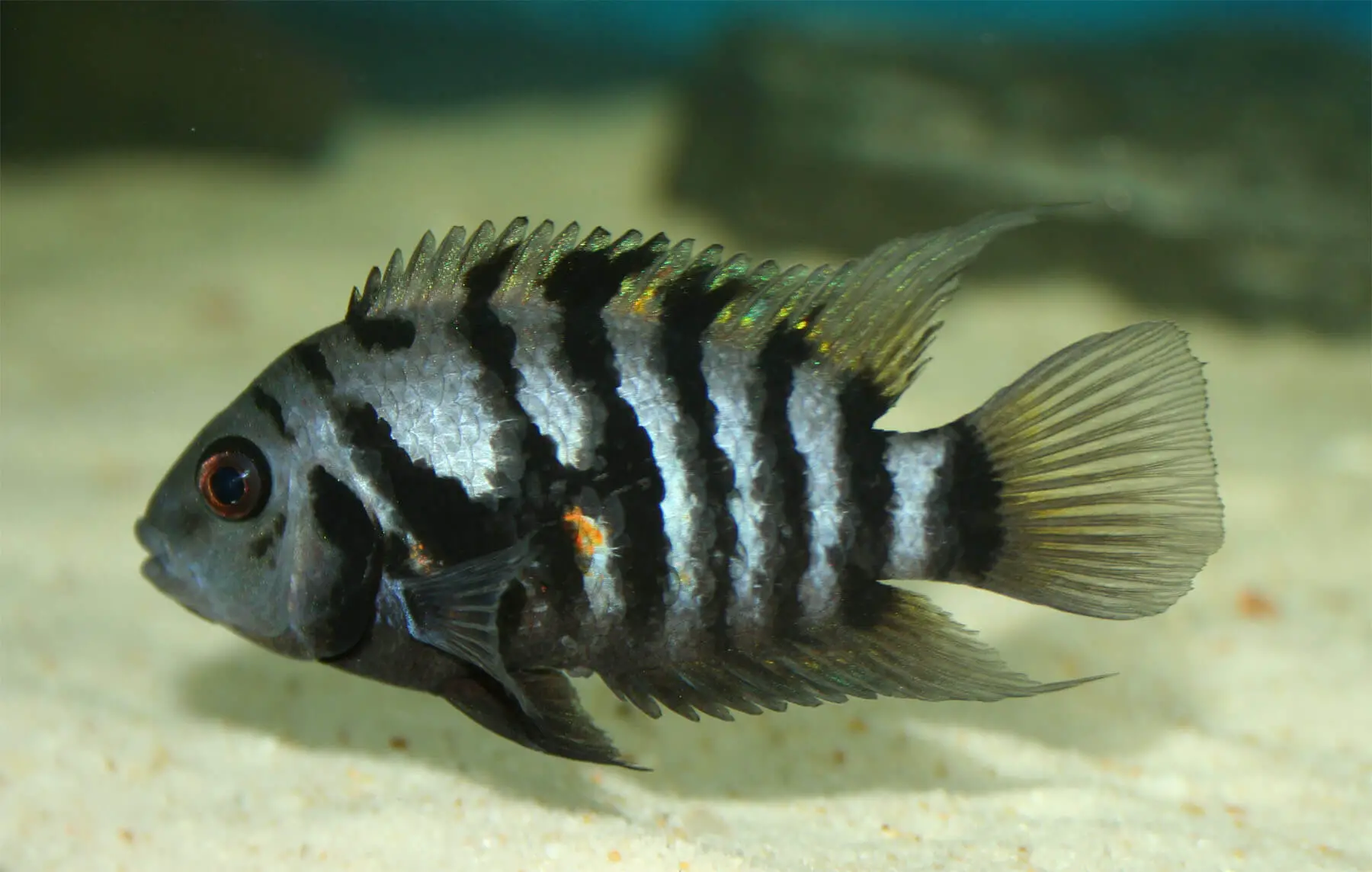
The Convict Cichlid is a freshwater fish that originates from Central America. It is a popular choice for aquariums because it is relatively small ( typically only grows to be about 4 inches long) and hardy. The Convict Cichlid can adapt to a range of water parameters, but ideally, they should be kept in a tank with a pH between 6.5 and 8.0 and a temperature between 72 and 82 degrees Fahrenheit.
Convict Cichlid also prefer tanks that are at least 40 gallons, as this gives them enough space to swim and explore. One advantage of the Convict Cichlid is that it is relatively low-maintenance, making it a good choice for beginner fish keepers.
However, one drawback is that they can be aggressive towards other fish, so it is important to carefully select tank mates. All in all, the Convict Cichlid is a great choice for those looking for a low-maintenance fish for their freshwater aquarium.
Mollies
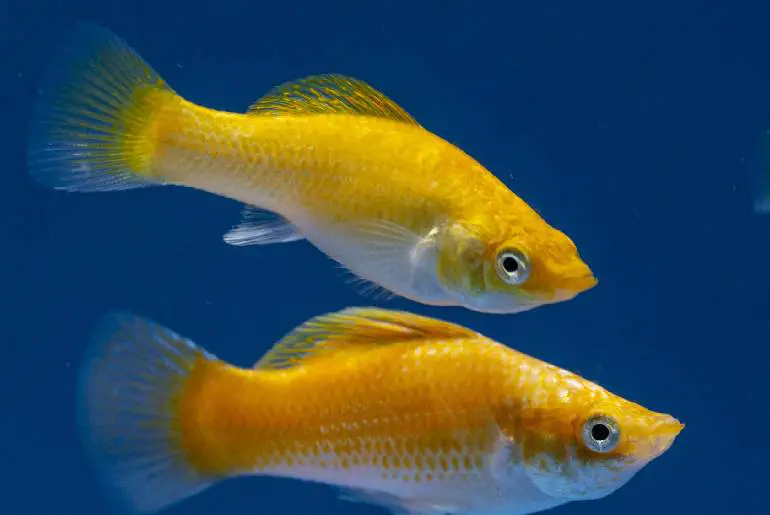
Mollies are a popular choice of fish for many aquarium enthusiasts, and it’s easy to see why. These beautiful fish come in a wide variety of colors and patterns, and they’re generally peaceful and easy to care for. In the wild, they can grow to be quite large, but in captivity, they usually max out at around 3-4 inches.
When it comes to keeping mollies in an aquarium, there are a few things to keep in mind. First, they prefer water that is on the warm side and has a slightly higher salt content than most other freshwater fish. They also need plenty of space to swim. So, a 40-gallon tank is ideal for a small group of mollies. And finally, although they’re not particularly finicky eaters, they do require a diet that is high in vegetable matter.
Assuming you can provide the proper environment, mollies make a great addition to any aquarium. They’re active and fun to watch, but they’re not overly playful or nippy. They’re also relatively hardy fish, so they’re a good choice for beginner aquarists.
Goldfish
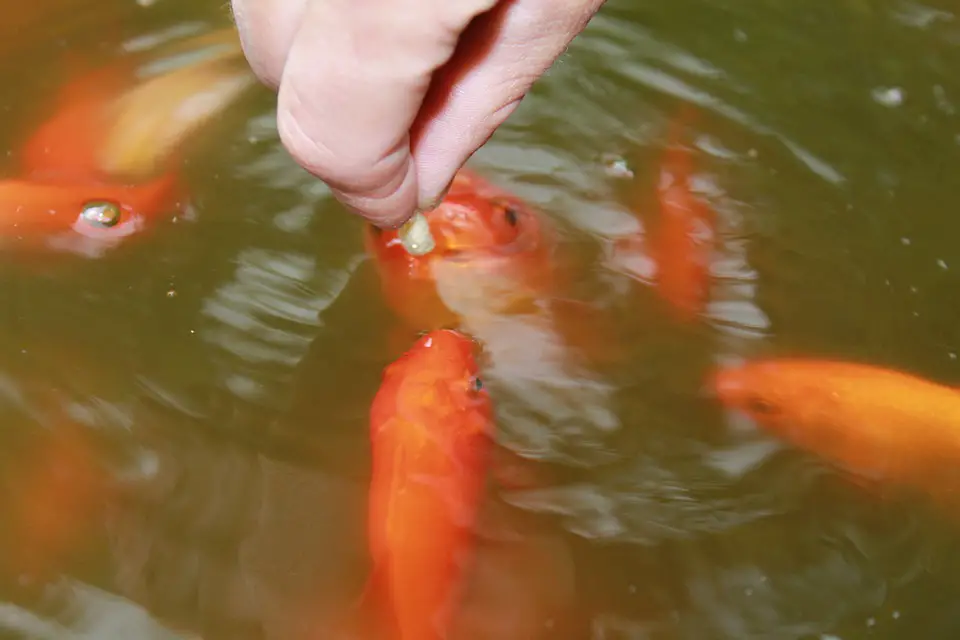
Goldfish originate from Asia, and they were first domesticated in China over a thousand years ago. Today, there are many different types of goldfish, but they all belong to the same species (Carassius auratus). Goldfish come in many different sizes, but the average adult fish is about 6-12 inches long.
As far as aquariums go, goldfish are not particularly demanding. They prefer water that is relatively cool (around 68-74 degrees Fahrenheit) with lots of plants and hiding places. Generally, they do best in tanks that are a little bigger. Therefore, 40 gallons in size is best for them.
There are several advantages to keeping goldfish as pets. They are relatively easy to care for, and they don’t cost very much to keep. Goldfish are also very entertaining to watch, and they can live for 10-20 years with proper care. All these things make a Goldfish the best option for your tank.
Three Spot Gourami

The Three Spot Gourami (Trichogaster trichopterus) is a freshwater fish that originates from Southeast Asia. It gets its name from the three conspicuous spots that are located on its body, and it is a member of the gourami family. Three Spot Gouramis typically grow to be about 4 inches in length, but they can reach up to 6 inches in some cases.
In terms of water parameters, they prefer water that is on the softer side with a neutral pH. They also prefer a tank that is at least 40 gallons in size, but they can do well in a larger tank as well. Some of the advantages of keeping Three Spot Gouramis include their peaceful nature and their ability to thrive in a variety of different water conditions.
However, there are some drawbacks to keep in mind as well. For example, Three Spot Gouramis are known for being jumpers, so it is important to make sure that their tank is properly sealed.
Overall, the Three Spot Gourami is a great choice for beginners and experienced fishkeepers alike. And if you’re looking for a fish for your 40-gallon tank, this just might be the perfect option for you!
Swordtails

Few freshwater fish are as popular as the swordtail. This hardy fish originates from Central America and can grow to be around four inches in length. Swordtails are relatively easy to care for, and they are tolerant of a wide range of water parameters. However, they do best in tanks that are at least 40 gallons in size.
One of the main advantages of swordtails is that they are peaceful fish that can be kept with a variety of tank mates. They are also relatively easy to breed, making them a good choice for beginner aquarists.
However, there are a few things to watch out for when keeping swordtails. They can be aggressive towards each other, especially during the breeding season. They also have a tendency to jump out of tanks that are not properly covered. All in all, swordtails make an excellent addition to any freshwater aquarium.
Platy
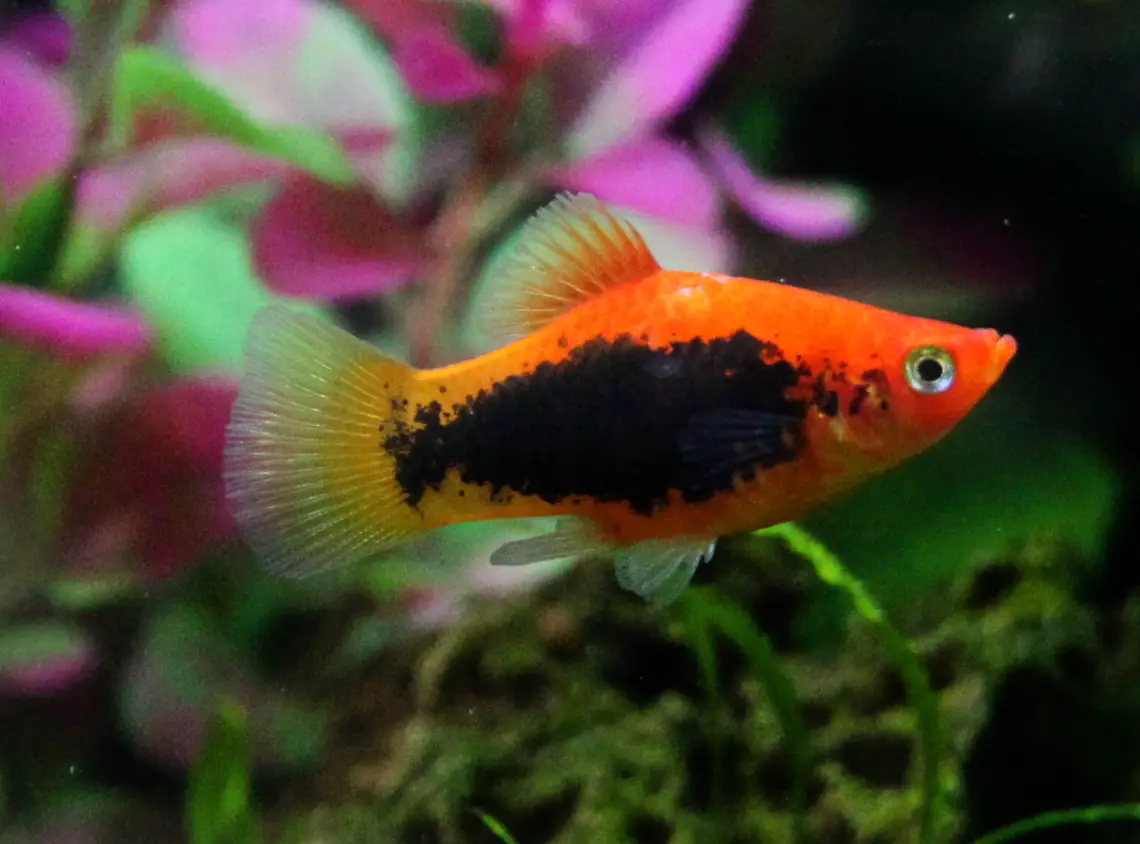
If you’re looking for a fish to add to your 40-gallon tank, you might want to consider the platy. This little fish originates from Central America and can grow to be about 2-3 inches long. Platies are relatively easy to care for, as they are tolerant of a wide range of water parameters. They prefer water that is on the warmer side, around 72-78 degrees Fahrenheit, and with a pH between 7.0 and 8.0.
Platies also do best in tanks that are at least 20 gallons in size. Therefore, a 40-gallon tank is more than enough for you to keep a few plates. You can even decorate it with plants and substrates as long as there are regular water changes.
One advantage of platies is that they are livebearers, which means they will give birth to live young rather than laying eggs. They are also generally peaceful fish and can get along well with other community tank mates.
However, one drawback is that platies are known to be fin nippers, so you’ll want to avoid putting them in with fish that have long fins (like bettas). All in all, the platy is a good choice for a beginner fishkeeper or someone looking for a hardy addition to their community tank.
Shell Dwellers
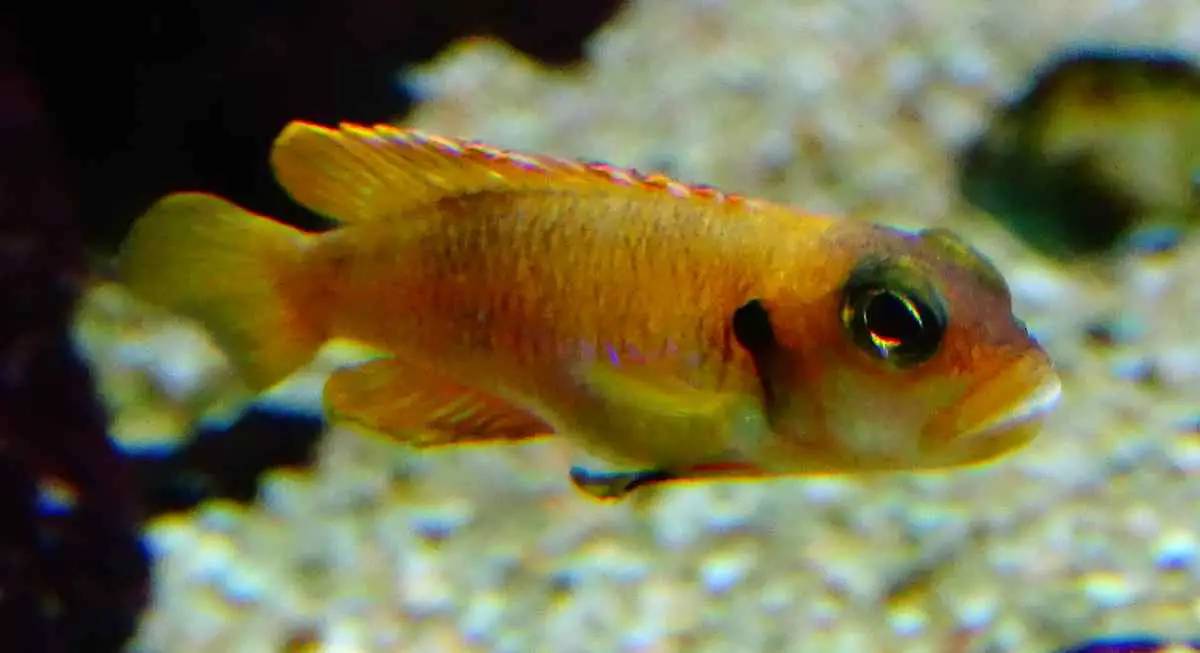
Shell Dwellers are a type of freshwater fish that originates from Africa. They are small, peaceful fish that do well in tanks of 40 gallons or more. The ideal water parameters for Shell Dwellers are a pH of 7.2-8.5, a temperature of 72-82 degrees Fahrenheit, and a hardness of 8-20 dGH.
Shell Dwellers do best in tanks that are heavily planted and have plenty of hiding places. They are also known to be good jumpers, so a tank with a tight-fitting lid is necessary. One advantage of keeping Shell Dwellers is that they are not demanding when it comes to water quality or diet. They are also relatively easy to breed in captivity.
However, one drawback is that they can be shy and reclusive fish, so they may not be the best choice for those looking for an active community tank.
Rock Dwellers
Rock dwellers are a type of bottom-dwelling fish that originates from Africa. They are typically quite small, only growing to be about two inches in length. However, they make up for their size with their personality, as they are very active and curious fish.
Due to their small size, Rock dwellers do not require a large tank; in fact, they do best in a tank that is at least 40 gallons. They also prefer water that is on the cooler side, with a temperature range of 72-78 degrees Fahrenheit being ideal.
One of the biggest advantages of rock dwellers is that they are very easy to care for and are very resilient fish. They are also great beginner fish for those new to the hobby. The biggest drawback of rock dwellers is that they can be quite nippy, so it is important to keep an eye on them if you have other fish in the tank.
Cyprichromis
The Cyprichromis is a small, colorful cichlid that originates from the waters of Lake Tanganyika in Africa. These fish are relatively peaceful and make an ideal addition to a community tank. They are also relatively easy to care for, provided their owner takes the time to research their needs.
Cyprichromis is one of the best fish for a 40-gallon tank because they stay fairly small (usually only reaching about 3 inches in length), and they prefer to stay near the bottom of the tank. These fish are also relatively tolerant of different water parameters, though they prefer water that is slightly alkaline.
In terms of tank mates, Cyprichromis get along well with other peaceful cichlids and bottom-dwelling fish. The only real drawback to these fish is that they can be sensitive to changes in water quality, so it is important to keep a close eye on your tank if you decide to add one or more of these fish.
Goodeids
Goodeids are a type of live-bearing fish that originates from central Mexico. They are small fish, only growing to be about 2 inches in length. Goodeids are very adaptable and can tolerate a wide range of water parameters, making them ideal for beginner aquarium hobbyists. However, they prefer slightly warmer temperatures and prefer waters with a neutral pH.
Goodeids also do best in groups, so a 40-gallon tank is the perfect size recommended for keeping them. They are relatively easy to care for and make an excellent addition to any community aquarium. One advantage of goodeids is that they are not aggressive and get along well with other peaceful fish species. Nevertheless, one drawback is that they are prone to Finrot, so it is important to regularly monitor water quality and maintain clean tanks.
Small Rainbowfish
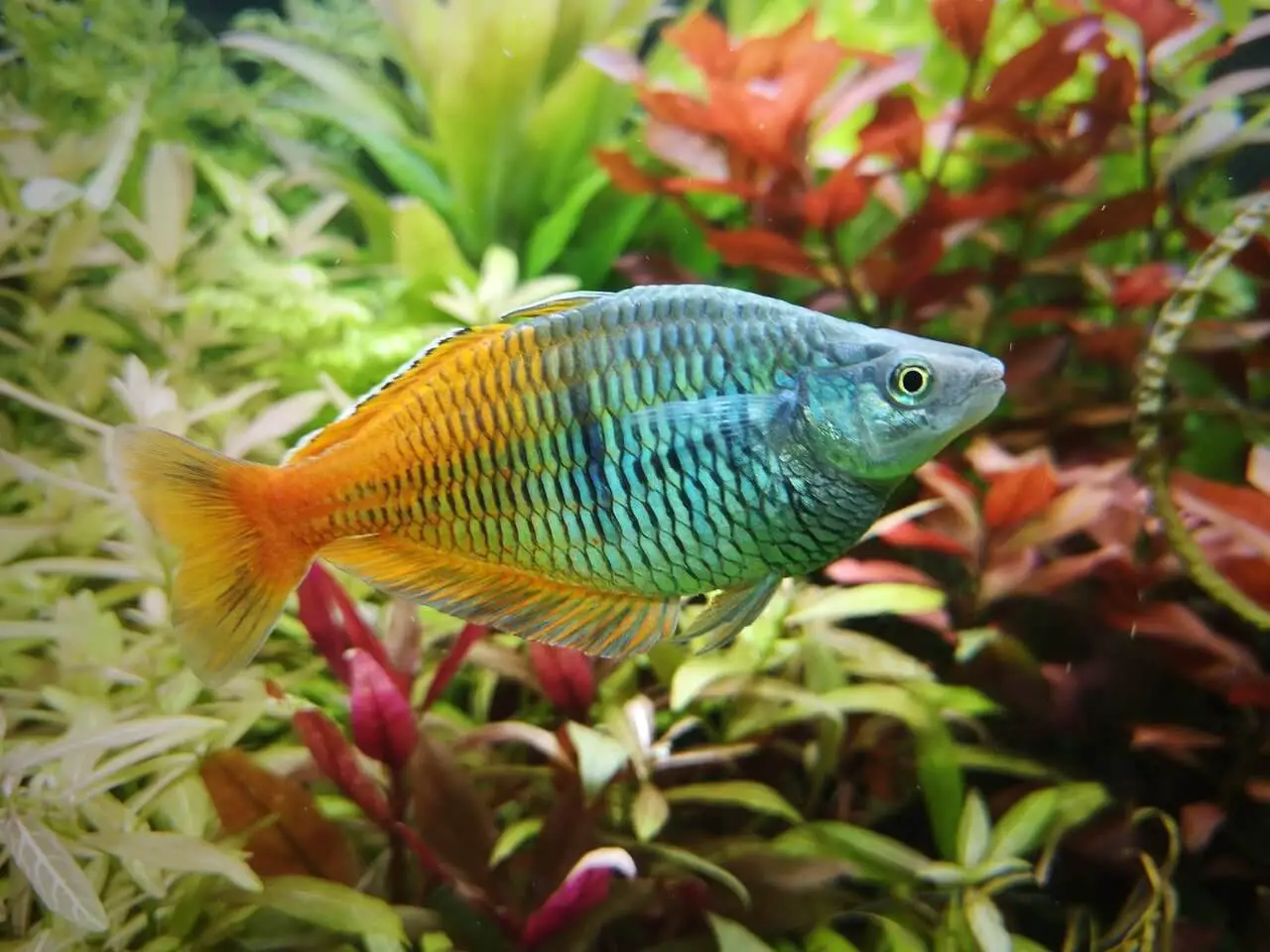
Small rainbowfish is a great choice for a 40-gallon tank. These fish are small, only growing to be about 2 inches long. They originate from Australia and New Guinea.
Small rainbowfish are very adaptable and can thrive in a wide range of water parameters. They prefer a water temperature of 72-82 degrees Fahrenheit and a pH of 6.5-7.5. Small rainbowfish also do best in tanks that have plenty of hiding places and lots of plants.
If you are planning on keeping more than one small rainbowfish in your tank, it is recommended to keep at least 5 fish together. This will help to reduce aggression between the fish.
Some potential drawbacks of keeping small rainbowfish include their need for live foods and their susceptibility to disease. Overall, these fish make an ideal addition to any aquarium.
Flowerhorn
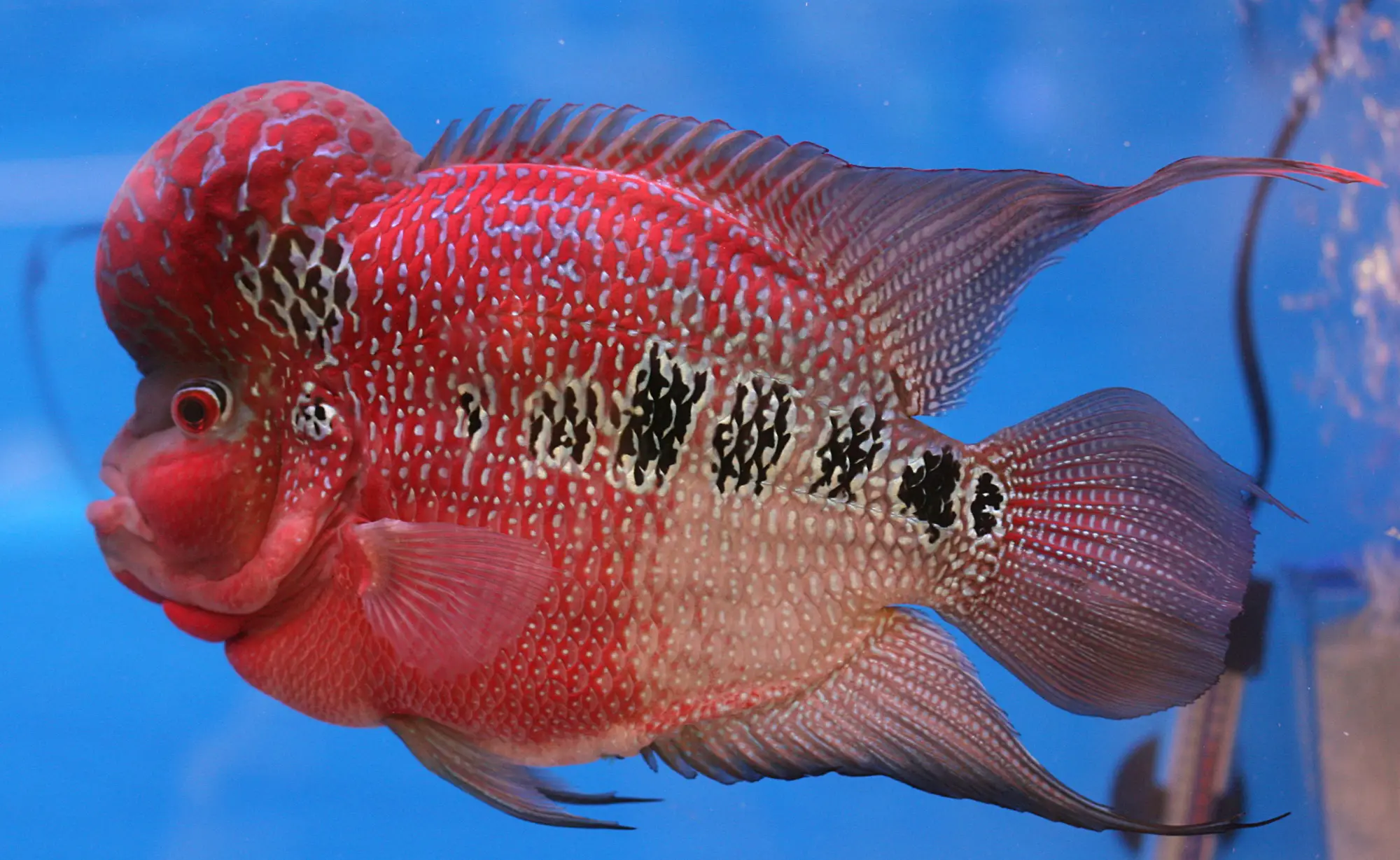
The Flowerhorn originates from Southeast Asia, where it was first bred in the 1990s. Flowerhorns are a hybrid fish created by crossing several different species of freshwater cichlids. These fish can grow to be quite large, with some specimens reaching up to 18 inches in length. As a result, they require a fairly spacious tank – a minimum of 40 gallons is recommended.
Flowerhorns are also fairly hardy fish and can tolerate a wide range of water conditions. However, they prefer water that is neutral to slightly alkaline, with a temperature between 75 and 80 degrees Fahrenheit.
When kept in ideal conditions, Flowerhorns are relatively easy to care for and make good additions to most community tanks. They are also very active fish, and their vibrant colors can add excitement to any aquarium.
However, there are some drawbacks to keeping Flowerhorns. These fish can be quite aggressive and may bully smaller tankmates. They also have a reputation for being messy eaters, which can lead to increased levels of nitrate in the water.
Overall, the Flowerhorn is a beautiful and interesting fish that can make a great addition to most community tanks. However, potential owners should be aware of the challenges that come with keeping this fish.
Bolivian Ram

The Bolivian Ram is a beautiful freshwater fish that originates from the rivers of Bolivia and Brazil. These fish are relatively small, only growing to be about 4 inches in length. Bolivian Rams are very peaceful fish and do well when kept in groups. They are also relatively easy to care for, as they are tolerant of a wide range of water parameters.
Ideally, Bolivian Rams should be kept in a tank that is at least 40 gallons in size. However, because they are peaceful fish, they can also be kept in a community tank with other peaceful species.
The main disadvantage of keeping Bolivian Rams is that they can be shy and may not always be visible in the aquarium. But overall, they make an excellent addition to any freshwater tank.
Juli Cordydoras

Juli Cordydoras originates from the swampy lowlands of South America. It is a hardy and peaceful fish that does well in a variety of water conditions. This fish grows to be about 3-4 inches in length, making it an ideal choice for a 40-gallon tank.
Juli Cordydoras is a peaceful community fish that gets along well with other similar-sized fish. It is an omnivore and will do well on a diet of pellets, flakes, and live or frozen foods. The Juli Cordydoras is a hardy fish that is tolerant of different water conditions, making it a good choice for beginning aquarists. However, because it originates from slow-moving waters, it does best in tanks with slow-moving or no filter currents.
Juli Cordydoras is also known to jump out of aquariums, so it is important to have a tight-fitting lid on your tank. Overall, the Juli Cordydoras is a great choice for a 40-gallon tank. It is a hardy fish that is tolerant of different water conditions and gets along well with other similar-sized fish.
Black Phantom Tetras

The Black Phantom Tetra is a freshwater fish that originates from the rivers of South America. These fish are relatively small, growing to an average size of two inches. Black Phantom Tetras are very peaceful fish and do well in tanks with other similar-sized fish.
When it comes to water parameters, these fish prefer neutral to slightly acidic water with a temperature range of 72-82 degrees Fahrenheit. As for tank size, a minimum of 30 gallons is recommended. However, 40 gallons is ideal in order to provide more swimming space and allow for proper filtration.
Some of the advantages of keeping Black Phantom Tetras include their low maintenance requirements and their low cost. In terms of drawbacks, these fish are relatively fragile and sensitive to changes in water quality. As a result, they may not be the best choice for beginner fish keepers.
Overall, the Black Phantom Tetra is a great option for those looking for a peaceful community fish that is easy to care for.
Long Fin Beistlenose Plecos

Longfin bristle nose plecos are a type of armored catfish that originates from South America. These fish are relatively small, only growing to be about 4-6 inches in length. They are also a peaceful species that do well in community tanks.
In terms of water parameters, longfin bristle nose plecos prefer water that is on the warmer side, with a temperature range of 76-82 degrees Fahrenheit. They also prefer water that has a moderate to a high level of hardness. In terms of tank size, these fish do best in tanks that are at least 40 gallons in size.
One of the advantages of keeping long-fin bristle nose plecos is that they are relatively easy to care for. These fish are also very good at algae control and can help to keep your tank clean. The only real drawback to these fish is that they require a larger tank than some other species of fish.
Oranda Goldfish

The Oranda Goldfish originates from China, where it was first bred for its distinctive hooded feature. Also known as the Lionhead Goldfish, this breed can grow to be about 12 inches long, making it one of the larger goldfish breeds. As a result, they require a tank that is at least 40 gallons in size.
Oranda Goldfish are also relatively high-maintenance in terms of water quality, and they require water that is well-oxygenated and has a neutral pH level. They are also sensitive to temperature changes, so the water in their tank should be kept at a consistent temperature.
Despite their high maintenance needs, Oranda Goldfish make great pets for beginner fish keepers. They are gentle fish that are known for being friendly and interactive with their owners. They are also very beautiful fish, and their hooded feature makes them unique among goldfish breeds.
Trout

Trout is a freshwater fish that originates from North America. It is a relatively small fish, only reaching about 12 inches in length. However, it is an active swimmer and needs plenty of space to move around. As a result, Trout is best kept in tanks that are at least 40 gallons in size.
Trout prefer water that is cool and clean, with a pH level of 6.5-7.5. They are also relatively easy to care for and are not overly sensitive to changes in water parameters. However, they can be aggressive towards other fish and should not be kept with smaller fish or fish that are not fast swimmers. Overall, Trout make an excellent addition to any freshwater tank and can thrive in a wide range of conditions. With proper care, they can live for 5-10 years in captivity.
Outro
If you’re looking for a fish to add to your 40-gallon tank, you might want to consider the Outro. This fish is native to the Amazon River Basin, where it typically grows to be about two inches long. While it’s a relatively small fish, it can actually do well in a tank of any size – making it a great option for those with limited space.
Outros are also relatively easy to care for, as they can tolerate a wide range of water parameters. However, there are a few things to keep in mind if you’re considering adding an Outro to your tank.
First, while they are peaceful fish, they can be territorial and may not do well with other species that occupy the same space in the water column. Additionally, Outros are known to be escape artists, so be sure your tank is properly sealed.
Overall, the Outro is a great choice for those looking for a small, low-maintenance fish – just be sure to provide them with plenty of hiding places and a tight-fitting lid.
Here I have given you a wide range of options to keep in your tank. But if you are like me, who enjoys keeping much fish in a single tank then I do have some specific community tank fish for a 40-gallon tank.
How To Stock A 40 Gallon Community Tank?
Some aqua enthusiasts prefer to keep various types of fish in their tanks. They love the color and variations that different fish provides in the tank. However, even if the fish fits in your tank, you must be very careful about the nature of the fish. I would suggest you avoid keeping two aggressive fish together as they can trouble you a lot.
Moreover, to help you here, I have listed all the different types of fish that you can keep in your 40-gallon tank with their nature. I hope it will help you in your fish-keeping journey!
Semi Aggressive
Semi-aggressive fish is a great option for stocking your 40-gallon tank. They add a bit of excitement and variety to your tank while still being relatively peaceful. Here are some great semi-aggressive fish for your 40-gallon tank:
Surface Dwellers
Some aquarists would like to have fish that stay at the top of the aquarium all the time. These are called surface dwellers, and they often have special adaptations to help them breathe air from above the water. Goldfish are a good example of a surface-dwelling fish. Few other surface dwellers that can fit perfectly in a 40-gallon tank are:
- Tiny Rocket Panchax
- Gaint Arowana
- Hatchetfish
- Pencilfish
- Danios
- Gouramis
- Mollies
- Platies
- Guppies
- Siamese Fighting Fish
Bottom Dwellers
Bottom feeders are fish that, you guessed it, spend most of their time near the bottom of the tank. These fish tend to be scavengers, which means they will eat just about anything. Some bottom feeders can get pretty big, so it’s important to do your research before adding one to your 40-gallon tank. A few popular bottom feeders include:
- Kuhli Loach
- Rosy Loach
- Amano Shrimp (Caridina multidentate)
- Dwarf Chain Loach (Ambastaia sidthimunki)
- Corydoras (genus)
- Hillstream Loach (Sewellia lineolate)
- Crayfish (Cambarus sp.)
- Yo-yo Loach (Botia almorhae)
- Otos (Otocinclus genus)
- Bristlenose Pleco (Ancistrus cirrhosus)
Middle Dwellers
Mid-water dwellers are, as you might expect, fish that spend the majority of their time in the middle of the tank. These fish are often active and need plenty of space to swim around. Some mid-water dwelling fish that would do well in a 40-gallon tank include:
- Neon Tetras
- Black Tetras
- Denisoni Barbs
- Rainbowfish
- Rasboras
- Tiger Barbs
- Congo Tetras
Cleaning Crew
Cleaning crews are fish that help to keep your aquarium clean. These fish are often seen as a necessary part of any aquarium, they can help to keep your tank free of algae and other debris. Many people choose to have a few different kinds of fish in their cleaning crew to make sure the job gets done right. Some popular options for cleaning crews include:
- Siamese Algae Eater (Crossocheilus oblongus)
- Rainbow Sharks
- Redtail Sharks
- Flagfish
- Corydoras
- Platies
- Loaches
- Common Goldfish
- Amano Shrimp
- Bristlenose Plecos
Aggressive Fish
Some fish are just naturally aggressive and should not be kept with other fish. These fish are often territorial and may attack other fish in the tank, which can lead to serious injury or even death. If you’re looking for an aggressive fish for your 40-gallon tank, you can consider one of these options:
- Cichlids
- Gourami
- Peacock Bass Cichlid
- Puffer
- Pea Puffer
- Jack Dempsey
- Poor Man’s Tropheus
- African Leaf Fish
- Green Texas Cichlid
- Umber Cichlid
- Arowana
- Oscar
- Black Wolffish
- Betta fish
- Plecostomus
So, there you have it! These are just a few of the best fish for a 40-gallon tank. With so many options to choose from, you’re sure to find the perfect fish for your aquarium.
How To Set Up A 40 Gallon Tank?
When it comes to setting up a tank, most fish keepers find this task very daunting. Especially, when it comes to preparing a tank as big as 40 gallons. The truth is, it’s not as complicated as you think. In fact, with a little bit of planning and effort, you can easily set up a stunning 40-gallon fish tank that will be the centerpiece of your home.
Here are the things you need to do to set up a 40-gallon fish tank:
Step One: Choose The Right Location For Your Tank
The first step in setting up your tank is to choose the right location for it. Keep in mind that a 40-gallon fish tank is quite heavy, so you’ll need to find a place that can support its weight. Also, make sure that the location you choose is near a power outlet so you can easily plug in your tank’s filter and other devices.
Step Two: Choose The Right Tank Stand
After finding a perfect location, it is very important to pick a tank stand. If you have a bigger tank, like a 40-gallon tank, a stand is very important. Keep in mind that you’ll need a sturdy stand that can support the weight of your tank. Also, make sure that the stand is tall enough so you can easily reach the top of your tank.
Step Three: Choose The Right Tank Filter
Like humans, your fish might not do well in a polluted and contaminated environment. Therefore, filters are crucial when you are planning to keep different fish in your tank.
However, most of you might get confused about the right filter to choose. I personally prefer a canister filter for my 40-gallon tank. Nevertheless, there are a lot of different types of filters available on the market, so it’s important to do your research and choose the one that’s right for your tank.
Step Four: Choose The Right Tank Heater
Water parameter plays a very important role in the well-being of your fish. Any fluctuation in the temperature of the water will affect your fish. I suppose you would never want that, would you?
So, you must always keep a heater in your tank. However, like filters, heaters also have lots of options. Do some research before you choose the best for your fish tank.
Step Five: Choose The Right Tank Lighting
Lightings are usually for the fish keepers rather than the fish. Mostly fish prefer living in the dark, like under the rocks and shells. But if your tank is completely dark, it would be a problem for you to monitor the actions of your fish.
Thus, you need to keep some lighting to make the fish and tank visible. However, since fish do not prefer intense lighting, always go for low lighting. You can also use LED lights to make your tank more energy-efficient.
Step Six: Choose The Right Tank Decorations
If you have set all the basics things, it’s time to add some decorations to your tank. This is completely up to you and your fish’s preference. I would suggest adding some live plants to your tank. Not only do they look good, but they also provide some cover for your fish.
You can also add some driftwood, rocks, and other decorations to make your tank more appealing. Just make sure that the decorations you choose are safe for your fish and won’t damage their fins or scales.
Step Six: Add Your Fish To The Tank
After following the above steps, now! You can add your fish to the tank. When adding fish to your tank, it’s important to do so slowly and carefully. Start by adding a few fish at a time and then wait a few days before adding more. This will give your fish time to adjust to their new environment.
Step Seven: Enjoy Your Tank!
The final step is to sit back and enjoy your beautiful 40-gallon fish tank. Make sure to take care of your fish and they will provide you with years of enjoyment. A 40-gallon tank can be a great tank for both experienced and novice aquarists. You just need to consider a few things while stocking.
How Many Fish Can You keep In A 40 Gallon Tank?
Usually, the number of fish to keep in a tank depends on the size and nature of the fish. In general, the rule of thumb is one inch of fish per gallon of water. This means that a 40-gallon tank can accommodate up to 40 inches of fish. But this is just a guideline, and there are other factors to consider when stocking your tank.
So, what are the things to consider when you stock your 40-gallon tank?
What Are The Things To Consider While Stocking Your 40 Gallon Tank?
The stocking of a 40-gallon tank is a crucial task that should be done with great care. There are certain things that need to be considered while stocking your tank so that you can maintain a healthy and balanced ecosystem for your fish. Here are some of the things to consider while stocking your 40-gallon tank:
The Size Of Fish
The size of the fish is an important factor to consider while stocking your tank. You need to make sure that the fish you are adding to your tank is not too big or too small for the space.
The Number Of Fish
The number of fish you add to your tank also plays a role in maintaining a healthy ecosystem. You need to make sure that you are not overstocking your tank, as this can lead to problems such as water pollution and fish stress.
The Type Of Fish
The type of fish you add to your tank also needs to be considered. You need to make sure that the fish you are adding are compatible with each other and will not fight or harm each other.
The Type Of Equipment You Use
The type of apparatus you use in your tank also plays a role in the health of your fish. You need to make sure that the equipment you are using is appropriate for the size and type of fish you have in your tank.
After considering all these factors, you can now start stocking your 40-gallon tank with the best fish for it. However, there are some advantages as well as disadvantages when it comes to keeping your fish in a tank as big as 40 gallons.
Are you aware of them?
What Are The Pros And Cons Of A 40 Gallon Tank?
Keeping your beautiful fish in a 40-gallon tank comes with both pros and cons that you should be aware of before making your purchase. Some of the pros of a 40-gallon tank include:
- A 40-gallon tank is much more affordable than some of the larger tanks on the market.
- They’re still large enough to house a fair number of fish and can even accommodate some of the larger species.
- A 40-gallon tank is also relatively easy to set up and maintain.
However, there are also some drawbacks that come along with owning a 40-gallon tank, such as:
- They don’t provide as much space as some of the larger tanks, so you may have to be more selective about the fish you put in them.
- A 40-gallon tank needs some qualitative equipment to maintain proper water quality.
- You may have to do more frequent water changes than with a larger tank.
Nevertheless, when you overlook these flaws, a 40-gallon tank can still be a great option for your home.
FAQs
What Are The Problems Of A 40 Gallon Tank?
A 40-gallon tank is a great size for many different types of fish. However, the problem with this tank is that the tank may not have enough space for all of the fish. This can cause problems with water quality, and the fish may not be able to thrive in the tank. Also, a 40-gallon tank may not have enough filtration. This can cause the water to become dirty, and the fish may not be able to stay healthy in the tank.
Another problem with a 40-gallon tank may not have enough aeration. This can cause the water to become stagnant, and the fish may not be able to breathe properly.
Should You Buy A 40 Gallon Tank?
If you are thinking about buying a 40-gallon tank, you should consider the problems that can occur in the tank. You should also think about whether or not you have the time to care for the fish properly.
If you do not have the time to care for the fish properly, you may want to consider a different size tank. If you have the time to care for the fish properly, a 40-gallon tank can be a great option for you.
Where Can You Buy A 40 Gallon Tank?
There are many places where you can buy a 40-gallon tank. You can buy the tank at a pet store, online, or in a fish store. When you are buying the tank, you should make sure that you buy a tank that is made for fish. You should also make sure that the tank is big enough for your fish.
What Are The Dimensions Of A 40 Gallon Tank?
The dimensions of a 40-gallon tank are 24 inches long, 12 inches wide, and 16 inches tall.
How Much Does A 40 Gallon Tank Cost?
Usually, the brand and material of the tank have a major influence on the price you need to pay for your tank. In general, a 40-gallon tank can cost from $100 to $1000, depending on what you choose.
Acrylic tanks can cost around $200, and a simple glass aquarium can be $135.
Conclusion
Summing up, these are our top picks for the best fish for a 40-gallon tank. We hope you’ve found this helpful and that you’ll be able to choose the perfect fish for your aquarium.
If you have any questions or suggestions, please feel free to leave a comment below. We love hearing from our readers!
Happy Fishkeeping! : )






